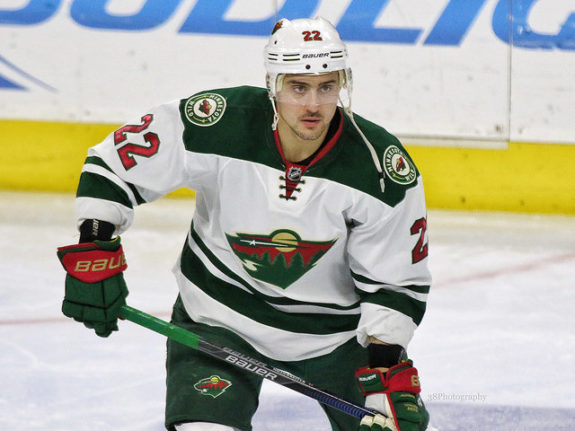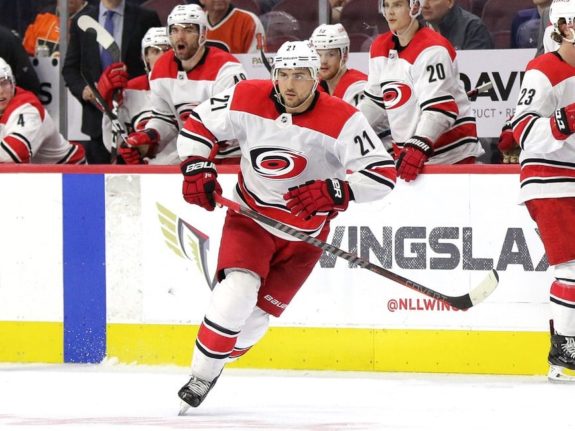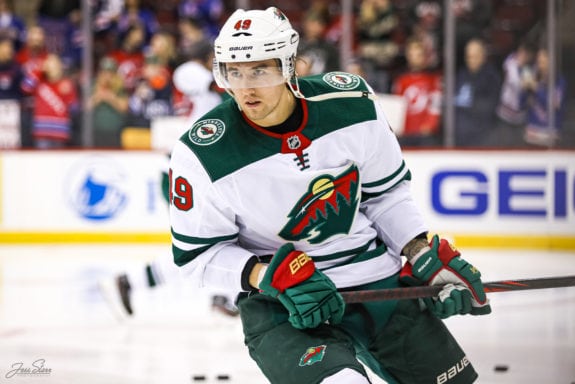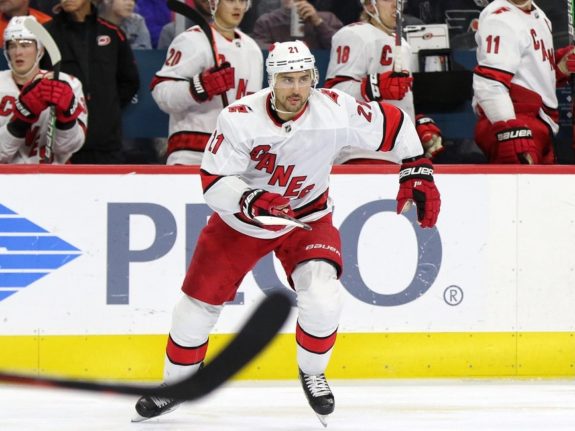One year has passed since the Carolina Hurricanes acquired Nino Niederreiter from the Minnesota Wild in exchange for Victor Rask. One-for-one swaps are rare in today’s NHL, but it was one month prior to the trade deadline and both players were in need of a change of scenery.
Niederreiter and Rask were both having down years offensively, but the trade accomplished different things for each club. The Wild are looking to get younger and shed salary, while the Hurricanes were seeking their first playoff berth in a decade and needed an extra oomph of offense.
The consensus at the time labeled the Hurricanes as the clear winner, as Niederreiter had more offensive potential and was the overall better player. But Rask has a $4-million cap hit compared to Niederreiter’s $5.25-million, and was also a natural center. So now that we’re at the anniversary mark of the trade, did the Hurricanes or Wild benefit more from the transaction?
Hot Start for Niederreiter
Searching for goal scoring, the Hurricanes took a stab at the Swiss winger, a former fifth-overall pick in 2010 by the Wild. Niederreiter enjoyed three straight seasons of 20-plus goals in Minnesota prior to the 2017-18 season, which was riddled by injuries. It was the first season since signing his five-year, $26.25-million contract, which he inked after scoring a career-high 57 points in 2016-17.

Finally healthy to start 2018-19, Niederreiter got off to a disappointing start with the Wild and was never able to find his groove. It took 15 games for Niederreiter to score his first goal of the season, even when Minnesota went 9-4-2 in that span. In total, he scored nine goals in 46 games before he was dealt to the Hurricanes on Jan. 17, 2019.
Joining a fresh new team that desperately needed his scoring talents, Niederreiter was rejuvenated. In the final 36 games of the season, he tallied 14 goals and 30 points playing alongside Sebastian Aho and Justin Williams. That top line’s emergence was a blessing for Aho in particular, whose previous linemates, Michael Ferland and Brock McGinn, didn’t have the finishing touch Niederreiter provided.

Boosted by Niederreiter’s arrival, the Hurricanes scorched to a 24-10-2 run to finish the season in an Eastern Conference wild-card spot. They even shocked the league by winning their first two playoff rounds. But the newcomer who had been red hot since pulling on the Hurricane crest went silent – in 15 playoff games, Niederreiter registered just one goal and three assists.
Grass Wasn’t Greener for Rask
Rask’s journey to Minnesota after five seasons and change in Carolina wasn’t as smooth of a transition. In fact, since joining the Wild, Rask has yet to show any of the offensive capabilities he displayed in previous years with the Hurricanes.
Coming off the heels of a 48-point season in 2015-16, then-general manager Ron Francis signed Rask to a six-year, $24-million contract. Similarly to Niederreiter, Rask faltered after landing a multi-year contract following a career-high season. In September of 2018, he suffered injuries to his fingers and never seemed to regain his scoring touch, eventually leading to his departure from the Hurricanes.

Rask was a fourth-line center towards the end of his tenure with the Hurricanes, and it’s a similar role he’s played in his 365 days with the Wild. While Niederreiter immediately thrived in Carolina, Rask’s struggles worsened with his new team. In 56 career games with the Wild, Rask has scored just six goals and seven assists. He’s playing just 10:12 per game this season, the lowest of his career.
Making Sense of the Trade
The Hurricanes were pushing for a playoff spot, and with the acquisition of Niederreiter, they accomplished that goal. But for the Wild, then-general manager Paul Fenton’s philosophy was different. The Wild were chasing the playoffs in the midst of a semi-rebuild, while sporting some of the league’s ugliest contracts – those for Zach Parise and Ryan Suter among them. Perhaps worrying Niederreiter’s regression could add to their future financial disarray, the Wild preemptively traded him.
Acquiring Rask saves Minnesota $1.25-million per year, but that doesn’t mean it’s a good contract, and it doesn’t mean it was a good deal. Fourth-line centers demand salaries in the ballpark of $1-2 million, and the 26-year-old Rask makes twice that amount.

His youth and ability to play down the middle were possible draws to Fenton, with the Wild’s top centers Eric Staal and Mikko Koivu now in the 35-and-over category. Unfortunately, Rask hasn’t done enough to prove he’s capable of middle-six minutes, and that’s indicated by his ice time. He is defensively sound, and can slot up and down the lineup, but it’s still an overpayment the Wild will be stuck with for the next three seasons.
Niederreiter Falling Off in Carolina
Back in Carolina, the trade paid immediate dividends for the Hurricanes, but they haven’t gotten the production they had hoped for with Niederreiter this season. The cold streak from last season’s playoffs has carried over to 2019-20, and while he’s not necessarily lagging behind his teammates, Niederreiter’s lack of scoring and poor discipline have weighed down his value. With six goals, 15 assists and 80 shots in 47 games, he’s on pace for some of the lowest totals of his career, excluding his rookie campaign. He has also taken 16 minor penalties this season on one of the league’s most penalized teams.

Now with Williams re-entering the picture and only 12 spots available for 13 forwards, the 27-year-old Niederreiter could find himself without a chair once the music stops. He was demoted to the Hurricanes’ fourth line in Thursday’s 3-2 loss against the Columbus Blue Jackets, indicating head coach Rod Brind’Amour has been pondering Niederreiter’s ineffectiveness as well.
The Hurricanes have the luxury of multiple players on team-friendly contracts, which – for now – allows room for Niederreiter’s oversized cap hit. That’s a stark contrast to the situation the Wild will be dealing with the next few years, which is perhaps what prompted Fenton to make the move at the time. Then again, it was also one of the decisions that ultimately led to his firing after just one year as GM.
While both players have undoubtedly underachieved, the scales still tip in the Hurricanes’ favor. If Niederreiter can find his game, get hungry, and snap out of the hex that has his shooting percentage lagging at 7.8 percent, he has the ability to regain his status as a 20-goal scorer in the Hurricanes’ top-six until his contract expires in 2023.